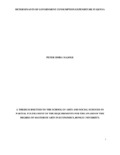| dc.description.abstract | Government expenditure is a very instrumental demand tool in achieving economic stability and policy makers frequently use it to influence certain economic outcomes. Government expenditure majorly consists of two components: investment and consumption components. Many researchers concede that higher level of government consumption expenditure is growth retarding and therefore undesirable. The aim of the study was establish the economic, structural and political and institutional determinants of government consumption expenditure in Kenya. Government consumption expenditure in Kenya has grown relatively faster from Ksh 31.2732 billion in 1963 to Ksh 2107.2 billion in 2018. There is still scanty literature on this topic and yet consumption expenditure accounts for more than 55% of Kenya’s total public spending every year. Because Shonchoy (2010) panel analysis suffers from cross-sectional heterogeneity and fails to be informative about Kenya’s consumption spending, it became a motivation to examine the causes for the rise in Kenya’s government consumption expenditure. Studies done by Kanano (2006) explained the reasons behind growth in gross expenditure, while Maingi (2010) and Abwoga (2013) focused on the effects of public consumption expenditure on economic growth in Kenya. However, their studies did not attempt to explain the causes of its growth. Oketch, T. O. and Linge, T. (2018) examined the determinants of recurrent public expenditure in Kenya but, however, reduced their scope and narrowed on salaries/wages, social contribution and non-wage related variables such as rent & utilities, travelling expenses, hospitality and other consumables and that focus makes this study deviate from their study. In light of this arguement, this study followed quantitative and correlational studies design to establish the reasons for rise in consumption expenditure in Kenya and drawing from the public choice approach, three models were used:(i) Economic model; consisted of gross domestic product, foreign aid, inflation rate, foreign direct investment, interest rate, trade openness and external debt stock (ii) Structural model; consisted of urbanization rate, young population (below 15 years) and old population (above 64 years) (iii) Politico-institutional model; comprised of market liberalization, political liberty, political cohesion, corruption and elections. Published data obtained from World Bank, Country Data Portal (2018) were used. Following cointegration test results on the time series data for the period 1963-2017, VECM, VAR and OLS estimations techniques were adopted. The results were that in the long-run, while 1USD increase in GDP causes USD1.3 increase in government consumption expenditure, a unit increase in inflation rate would cause USD1.8 increase in consumption expenditure. However, 1USD increase in foreign direct investment and external debt stock causes, respectively, USD 0.07 and USD 2.6 drop in government consumption expenditure. Corruption, democracy and political instability have positive effects on government consumption expenditure in Kenya. Urbanization and population dynamics jointly affect the variable in the short-run. This study recommends that the government should strengthen its institutions that are mandated to deal with graft cases, create peaceful political setting at all times and ensure a friendly environment to foreign investors | en_US |

